Art Concrete How-to
9: Testing Shapecrete®
THIS PAGE is one of several explaining techniques about how to use concrete in small-scale art projects.
| Book: Concrete Handbook for Artists: Technical Notes for Small-scale Objects. More information? |
What follows is a quick initial review of Shapecrete® as a potential material for jewelry.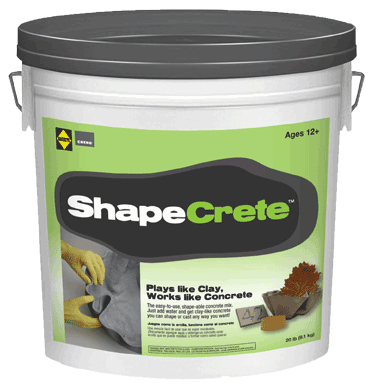
WHAT IS IT?
Shapecrete® is a new pre-mixed concrete powder available in the United States and Canada. It was developed by Sacrete, a well-known concrete redi-mix company, in collaboration with Fu-Tung Cheng, founder of Cheng Design and author of several books on concrete countertops and other uses for concrete in the home. The Shapecrete website describes it as "a high-performance, versatile concrete mix that can be shaped, sculpted, molded, or cast to make concrete projects limited only by the imagination."
WHAT'S IN IT?
All the dry materials are pre-mixed in a 20 lb. plastic pail. All you need is water. So what's in it? How does it compare to making your own high performance concrete from scratch? First of all it is a proprietary mix, so my comments here are really just speculation and educated guesses. Material Safety Data Sheets can give some clues, although they only have to list hazardous materials. My comments are in brackets.
MSDS:
-- Quartz (sand?) 40-70%
-- Portland cement and chemicals (don't know what chemicals) 15-40%
-- Gypsum (controls the setting of the cement) 1-5%
-- Kaolin 1-5%
-- Cement, alumina, chemicals (as in ciment fondu?) 1-5%
-- Limestone 1-5%
If you average out those quartz and Portland cement numbers, you get about 55% sand and 27% Portland cement, so looks like about a 2:1 ratio of aggregate to cement. The kaolin at 1-5% is probably a metakaolin, or a pozzolan, which increases the strength of the mix. High performance concretes usually have about 8% metakaolin but perhaps there are other pozzolans in the mix. When you look at the powder you can see it has a lot of very fine fibers in it, these could be nylon, polypropylene or PVA. These help lessen shrinkage cracks and also add some tensile strength. It appears to be a well balanced mix of aggregates, Portland cement, fibers and additives.
TESTING PROCESS:
With these first tests I am mixing Shapecrete on a very small scale, a jewelry scale. I am using Plasticene (modeling clay) as a quick mold-making technique to cast small shapes and see the results. This first series of images shows the Shapecrete after 24 hours. The last few are after 48 hours. In mixing the dry Shapecrete with water my first impression is that it is grittier than the mixes I would normally be using for jewellery-scale shapes. I can feel the sand particles. The water mixes in easily -- and there is no need to mix the dry ingredients together first. The abundance of fibers in the dry mix keeps everything nicely distributed throughout the pail. I mix about a tablespoon of dry mix with enough water for a fairly firm mix, one that would not slump unless agitated. After pressing the wet mix into the soft molds, I tap the molds a bit and agitate them so that it I can see the mix slump and look wet on the surface. I do not use any vibration or release agents to lessen air bubbles forming. I am only interested in setting times, colour, strength, aggregate size.
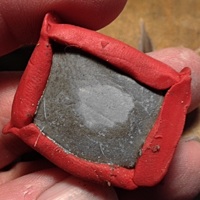
|
1. This is the top of one casting after 24 hours wrapped in plastic film to prevent drying out. The concrete is surprisingly hard after 24 hours. A fingernail barely scratches the surface. A steel point will scribe a line, but not easily. See picture 15 below. |
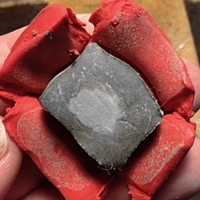
|
2.Opening the Plasticene mold up. The concrete, when damp, is slightly darker than I expected. I'm not sure if this is from the colour of the Portland cement, the additives, or the aggregates used. The concrete is hard enough that I can now keep it under water to cure. (This would normally be possible after two or three days.) After finishing the edges or filing or drilling into it, I would let it cure for another week before sealing it. |
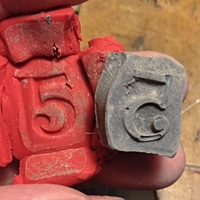
|
3. Taking the concrete piece out. You can see there were a couple of large air bubbles there. But it picked up detail really well. Normally after 24 hours you would have to be careful with those sharp corners. They could break easily. But not with this mix -- they are very stable. |

|
4. This could be a problem. Shrinkage cracks, even with those fibers in the mix. This was the second mix I did and I had made it a bit wetter to see if would pick up more detail. (The wetter the mix, the more shrinkage as the concrete sets.) The excess water could have led to the shrinkage cracks. This was a 24 hour cure as well. |
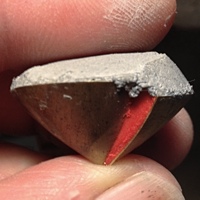
|
5. Using a small sheet brass metal mold to cast the Shapecrete, with Plasticene to fill in gaps. I shaped the exposed concrete with a plastic spatula before it set. Again, this is 24 hours after casting. |
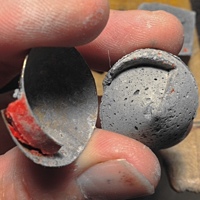
|
6. Removed from the brass mold. Lots of air bubbles here. I didn't use a release agent -- it would have helped. And I didn't vibrate the mold. But even small details along the edges came out clean. A Shapecrete mix would be too coarse to fill in those holes, but I could use a slurry of cement and stone dust to fill them in and sand the surface smooth. |
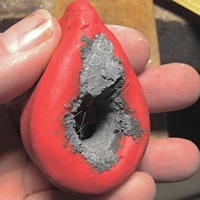
|
7. Casting a very quick ring form using Plasticene. The Plasticene has a v-shaped groove in it and I just packed the Shapecrete into it from the inside. It held together nicely, even upside down in the mold. With this piece I'm looking to test how the Shapecrete can be carved, formed and sanded after casting a rough shape. |
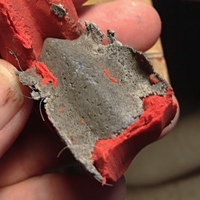
|
8. 24 hours later, pulling the Plasticenen off. There is lots of excess concrete outside the mold. |
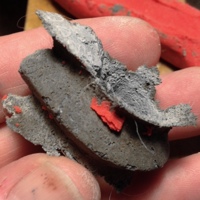
|
9. I then have to break, grind or sand off the excess. You can see some of the fibers that are imbedded in the mix. Any thickness of material over about 2 mm I cannot break off with fingers but have to use pliers. Impressively tough after such a short time. |
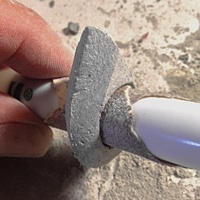
|
10. The ring form has now been sanded down with very coarse sandpaper, inside and outside. |
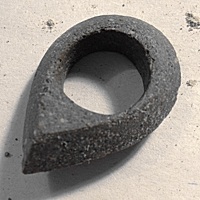
|
11. Still more sanding, and more to do. |

|
12. Another view of those shrinkage cracks. |
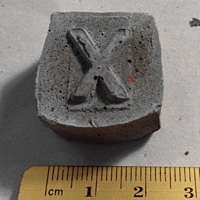
|
13. Another casting. Lots of tiny air bubbles here, not the fault of the mix. I'm showing this because it shows some textile texture that was the background for the letter X and the mix picked it up. Lots of potential for detail. If I had vibrated this piece and used a release agent I probably could have got rid of those bubbles. |
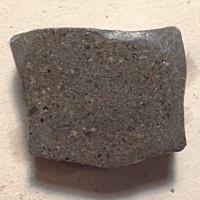
|
14. A surface wet sanded after 48 hours (320/600 grit) reveals the size and colour of the aggregate. It looks like a common sand to me. Some light, some dark, some with a bit of colour. Particles are up to about 1-1.5 mm in size (1/32"). |
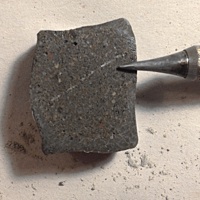
|
15. This is the same surface, 48 hours after casting. I scribed a line with a hardened steel scriber across the surface. It is remarkably tough for a 48 hour cure. It also means you would have to work fairly quickly to do any shaping or carving work before it gets too hard. 12 hours might be about right depending on temperature. (These tests were done during a heat wave, about 28 degrees C inside my studio.) |
CONCLUSIONS:
My initial reactions are very positive. It has great potential as a jewellery material, although it is mainly being promoted as a medium for larger work such as containers, planters and so on. I guess the market for Sacrete selling to jewellers is pretty limited, considering how long a bucket will last us! It has a basic "concrete" aesthetic to it, dark and granular. It sets up really fast, and at least in the first two days appears to be very tough. I think Sacrete has got it right. I have to do more experiments at a larger scale, but I'm optimistic from watching their how-to videos that it succeeds there as well. It's great advantage is that it gives everyone -- professional and hobbyist, maker and experimenter -- access to high performance concrete without having to find the many obscure materials that go into a mix like this.
| Home | HOW-TO | Materials | Small Scale | Mesh | Casting | Colour | Hazards | Books | Sources | Shapecrete |
CONTACT + LEGAL
Last update: 2016.